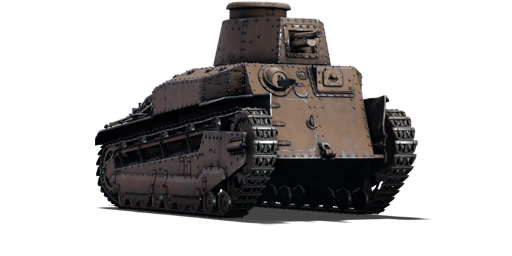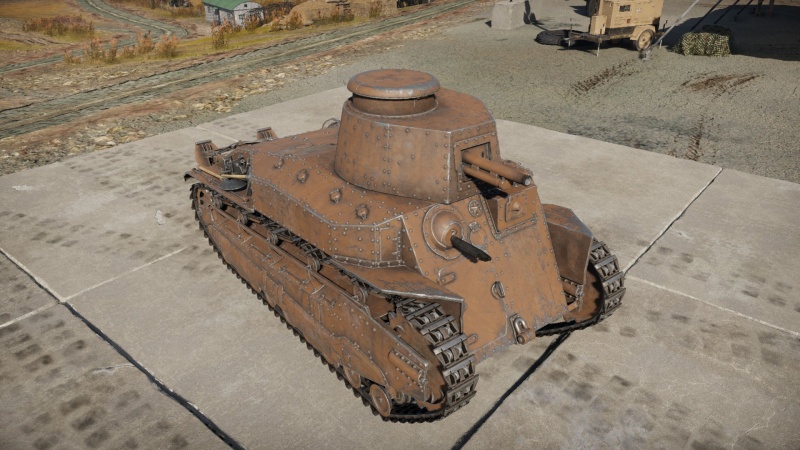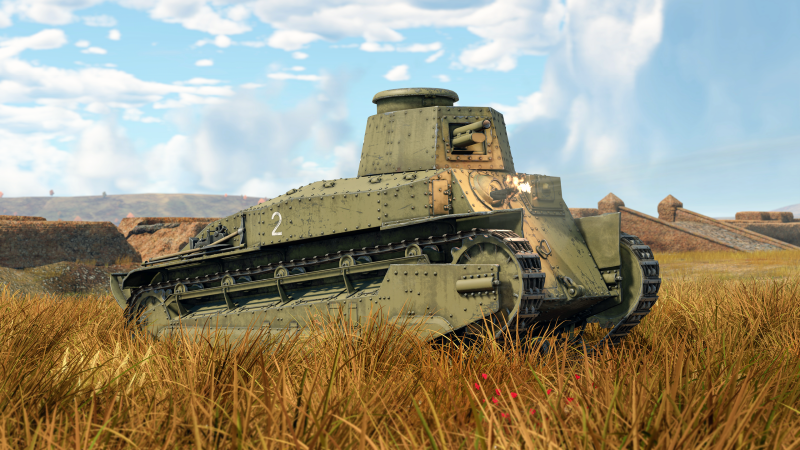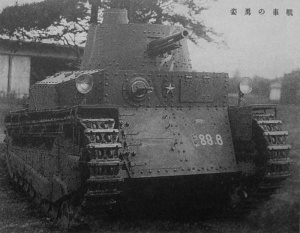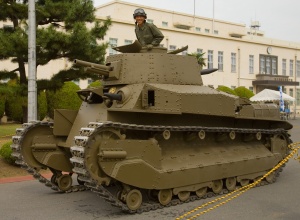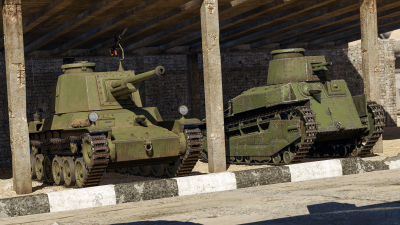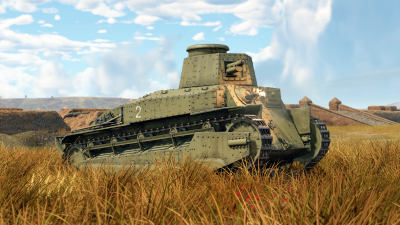Difference between revisions of "I-Go Ko"
Colok76286 (talk | contribs) (Edits) |
|||
| (57 intermediate revisions by 16 users not shown) | |||
| Line 1: | Line 1: | ||
| − | {{Specs-Card|code=jp_type_89b_i_go_otsu}} | + | {{Specs-Card |
| + | |code=jp_type_89b_i_go_otsu | ||
| + | |images={{Specs-Card-Image|GarageImage_{{PAGENAME}}.jpg|ArtImage_{{PAGENAME}}.png}} | ||
| + | }} | ||
== Description == | == Description == | ||
| − | ''In the description, the first part | + | <!-- ''In the description, the first part should be about the history of the creation and combat usage of the vehicle, as well as its key features. In the second part, tell the reader about the ground vehicle in the game. Insert a screenshot of the vehicle, so that if the novice player does not remember the vehicle by name, he will immediately understand what kind of vehicle the article is talking about.'' --> |
| + | The '''{{Specs|name}}''' {{Annotation|八九式中戦車 (乙型)「イ号」|Hachikyū-Shiki Chū-Sensha (Otsu-Gata) [I-Gō]}} was Japan's first domestic mass-produced tank, with the model B (otsu) being the world's first diesel-powered mass-produced tank to boot. Design started in 1925 as a light tank project planned on the FT-17, but the design based on the Vickers Medium C, the I-Go was adopted in 1929 as a light tank but shortly after reclassified as a medium tank for weighing over 10 tons. Well regarded in its early career against the poorly armoured forces of the Chinese, it couldn't keep up with motorized infantry and was easily outgunned at Khalkin Gol, and would be phased out by the 2nd generation of Imperial Japanese tanks, the [[Ha-Go]] and [[Chi-Ha]]. | ||
| + | |||
| + | It was introduced in [[Update 1.65 "Way of the Samurai"]] along with the rest of the initial Japanese Ground Forces Tree. While a slow infantry support tank, with little armour for tank combat, it comes equipped with a low velocity 57 mm cannon loaded with capable HEAT shells, able to lob high penetrating shells at close range and behind cover. Making for a challenging task for new tankers, it will serve as a trial by fire to learn positioning and shell trajectory with a glass cannon. | ||
== General info == | == General info == | ||
=== Survivability and armour === | === Survivability and armour === | ||
| − | ''Describe armour protection. Note the most well protected and key weak areas. Appreciate the layout of modules as well as the number and location of crew members. Is the level of armour protection sufficient, is the placement of modules | + | {{Specs-Tank-Armour}} |
| + | <!-- ''Describe armour protection. Note the most well protected and key weak areas. Appreciate the layout of modules as well as the number and location of crew members. Is the level of armour protection sufficient, is the placement of modules helpful for survival in combat? If necessary use a visual template to indicate the most secure and weak zones of the armour.'' --> | ||
| + | The armour on the I-Go Ko is lacking against contemporary enemies. With an armour thickness of less than 20 mm (aside from the spaced areas) all over, even large-calibre machine guns can penetrate the tank frontally. Not to mention, the front armour is only mildly sloped and presents a large target that can result in the vehicle being knocked out with a single penetration. It is recommended to not rely on your armour, nor advance on an enemy unless they are incapacitated (i.e. gunner or cannon knocked out). | ||
| + | |||
| + | '''Armour type:''' | ||
| + | |||
| + | * Rolled homogeneous armour | ||
| + | |||
| + | {| class="wikitable" | ||
| + | |- | ||
| + | ! Armour !! Front !! Sides !! Rear !! Roof | ||
| + | |- | ||
| + | | Hull || 17 mm (32°) ''Front glacis'' || 17 mm ''Top'' <br> 17 + 17 mm ''Bottom'' || 17 mm (61°) ''Top'' <br> 17 mm ''Bottom'' || 10 mm | ||
| + | |- | ||
| + | | Turret || 17 mm (9°) ''Turret front'' <br> 25 mm (10°) ''Gun mantlet'' || 15 mm (10-12°) || 15 mm (11°) || 10 mm | ||
| + | |- | ||
| + | | Cupola || 15 mm || 15 mm || 15 mm || 10 mm | ||
| + | |- | ||
| + | |} | ||
| + | '''Notes:''' | ||
| − | + | * Suspension wheels and tracks are both 15 mm thick. | |
=== Mobility === | === Mobility === | ||
| − | ''Write about the mobility of the ground vehicle. Estimate the specific power and | + | {{Specs-Tank-Mobility}} |
| + | <!-- ''Write about the mobility of the ground vehicle. Estimate the specific power and manoeuvrability, as well as the maximum speed forwards and backwards.'' --> | ||
| + | |||
| + | {{tankMobility|abMinHp=183|rbMinHp=104}} | ||
| + | |||
| + | Much like the armour, the {{PAGENAME}} leaves something to be desired in the mobility department. While the tank is reasonably mobile in close-quarters situations due to the good acceleration, the poor top speed will result in long trips across large maps and between capture points compared to other reserve tanks. | ||
| + | |||
| + | === Modifications and economy === | ||
| + | {{Specs-Economy}} | ||
== Armaments == | == Armaments == | ||
| + | {{Specs-Tank-Armaments}} | ||
=== Main armament === | === Main armament === | ||
| − | ''Give the reader information about the characteristics of the main gun. Assess its effectiveness in a battle based on the reloading speed, ballistics and the power of shells. Do not forget about the | + | {{Specs-Tank-Weapon|1}} |
| + | <!-- ''Give the reader information about the characteristics of the main gun. Assess its effectiveness in a battle based on the reloading speed, ballistics and the power of shells. Do not forget about the flexibility of the fire, that is how quickly the cannon can be aimed at the target, open fire on it and aim at another enemy. Add a link to the main article on the gun: <code><nowiki>{{main|Name of the weapon}}</nowiki></code>. Describe in general terms the ammunition available for the main gun. Give advice on how to use them and how to fill the ammunition storage.'' --> | ||
| + | {{main|Type 90 (57 mm)}} | ||
| − | === | + | {| class="wikitable" style="text-align:center" width="100%" |
| − | '' | + | |- |
| + | ! colspan="5" | [[Type 90 (57 mm)|57 mm Type 90]] || colspan="5" | Turret rotation speed (°/s) || colspan="4" | Reloading rate (seconds) | ||
| + | |- | ||
| + | ! Mode !! Capacity !! Vertical !! Horizontal !! Stabilizer | ||
| + | ! Stock !! Upgraded !! Full !! Expert !! Aced | ||
| + | ! Stock !! Full !! Expert !! Aced | ||
| + | |- | ||
| + | ! ''Arcade'' | ||
| + | | rowspan="2" | 100 || rowspan="2" | -15°/+20° || rowspan="2" | ±180° || rowspan="2" | Vertical || 14.47 || 20.03 || 24.32 || 26.90 || 28.61 || rowspan="2" | 4.29 || rowspan="2" | 3.80 || rowspan="2" | 3.50 || rowspan="2" | 3.30 | ||
| + | |- | ||
| + | ! ''Realistic'' | ||
| + | | 9.04 || 10.64 || 12.92 || 14.30 || 15.20 | ||
| + | |- | ||
| + | |} | ||
| + | |||
| + | ==== Ammunition ==== | ||
| + | {{:Type 90 (57 mm)/Ammunition|Type 92 APHE, Type 3 HEAT}} | ||
| + | |||
| + | ==== [[Ammo racks]] ==== | ||
| + | [[File:Ammoracks_{{PAGENAME}}.png|right|thumb|x250px|[[Ammo racks]] of the {{PAGENAME}}]] | ||
| + | <!-- '''Last updated: 2.27.2.40''' --> | ||
| + | {| class="wikitable" style="text-align:center" | ||
| + | |- | ||
| + | ! Full<br>ammo | ||
| + | ! 1st<br>rack empty | ||
| + | ! 2nd<br>rack empty | ||
| + | ! 3rd<br>rack empty | ||
| + | ! 4th<br>rack empty | ||
| + | ! 5th<br>rack empty | ||
| + | ! Visual<br>discrepancy | ||
| + | |- | ||
| + | | '''100''' || 97 ''(+3)'' || 61 ''(+39)'' || 49 ''(+51)'' || 13 ''(+87)'' || 1 ''(+99)'' || No | ||
| + | |- | ||
| + | |} | ||
| + | '''Notes''': | ||
| + | |||
| + | * Racks disappear after you've fired all shells in the rack. | ||
| + | * To minimize rack detonation, it is recommended to empty all the way to the 3rd rack with 49 ''(+51)'' shells. | ||
| + | {{Clear}} | ||
=== Machine guns === | === Machine guns === | ||
| − | ''Offensive and anti-aircraft machine guns not only allow you to fight some aircraft | + | {{Specs-Tank-Weapon|2}} |
| + | <!-- ''Offensive and anti-aircraft machine guns not only allow you to fight some aircraft but also are effective against lightly armoured vehicles. Evaluate machine guns and give recommendations on its use.'' --> | ||
| + | {{main|Type 91 (6.5 mm)}} | ||
| − | == Usage in | + | The Type 91 machine gun is mounted in the hull with limited traverse. With a limited magazine capacity, slow traverse speed, and small calibre, this machine gun usually doesn't serve much use in combat except as a tool against open-topped SPAA or tank destroyers, or to ping enemies on the map for teammates to see. As is common with many Japanese tanks, the turret is not fitted with a forward facing coaxial machine gun, so this machine gun is the I-Go Ko's only other weapon option if the main gun is incapacitated. |
| − | ''Describe the tactics of playing in the vehicle, the features of using vehicles in the team and advice on tactics. Refrain from creating a "guide" - do not impose a single point of view but give the reader food for thought. Describe the most dangerous enemies and give recommendations on fighting them. If necessary, note the specifics of the game in different modes (AB, RB, SB).'' | + | |
| + | {| class="wikitable" style="text-align:center" width="50%" | ||
| + | |- | ||
| + | ! colspan="5" | [[Type 91 (6.5 mm)|6.5 mm Type 91]] | ||
| + | |- | ||
| + | ! Mount !! Capacity (Belt) !! Fire rate !! Vertical !! Horizontal | ||
| + | |- | ||
| + | | Hull || 3,000 (30) || 499 || ±22° || ±25° | ||
| + | |- | ||
| + | |} | ||
| + | |||
| + | == Usage in battles == | ||
| + | <!-- ''Describe the tactics of playing in the vehicle, the features of using vehicles in the team and advice on tactics. Refrain from creating a "guide" - do not impose a single point of view but instead give the reader food for thought. Describe the most dangerous enemies and give recommendations on fighting them. If necessary, note the specifics of the game in different modes (AB, RB, SB).'' --> | ||
| + | The Type 89b I-Go Ko, despite its rather tractor-esque look, is a mobile tank that could use its speed to get to an enemy's flanks and cause some serious damage. The 57 mm cannon is unfortunately rather pitiful even in Rank I, with a penetration value of between 20 to 30 mm with APHE at standard combat ranges. Therefore, it is usually best to catch enemies unaware and go for flanking shots against their weaker side armour by driving around, instead of directly toward them. The 57 mm low-velocity shell does have an advantage of a rather prominent parabolic trajectory so it is possible to lob shells over hills to hit unsuspecting enemies behind it. | ||
| + | |||
| + | The gun's poor penetration will change when using the High Explosive Anti-Tank (HEAT) shell. This shell has 55 mm of penetration at any range but still has considerable drop-off due to the low velocity of the gun. It's a good enough anti-everything shell that can penetrate most targets you will meet, especially those pesky French tanks, which tend to be quite well armoured. The Type 3 HEAT shell, fortunately, has just enough penetration to get through them, although it is generally recommended to try to aim for weak spots and be prepared for the shell to not penetrate. This shell will also most likely destroy any truck or open-topped vehicle with a good hit. | ||
| + | |||
| + | '''Specific enemies worth noting:''' | ||
| + | |||
| + | Pretty much everything is a threat to this vehicle due to its mediocre mobility and poor armour. Fast vehicles like the [[M2A4]], [[BT-5]], [[A13 Mk I]], and [[AMD.35]] in particular are a difficult encounter; the I-Go Ko is reasonably fast at close quarters, but not that fast. The tank's sluggish turret traverse makes tracking a close target difficult and at long range the slow shells are difficult to aim precisely at a moving target. The [[20-K (45 mm)|45 mm 20-K]] gun that the commonly encountered BT series have can easily destroy you at any range with a well-aimed shot. | ||
| + | |||
| + | Vehicles with autocanons and heavy machine guns like the [[M2A2]], [[GAZ-AAA (DShK)]], [[Pz.II C]], and [[T-60]], are the I-Go Ko's worst nightmare. Their high volume of fire and good mobility coupled with the I-Go Ko's lack of a coaxial or pintle-mounted MG puts the I-Go Ko at a large disadvantage. SPAAs generally should be considered by the I-Go Ko to be just as deadly, if not more so, than conventional tanks. | ||
| + | |||
| + | One more vehicle type to worry about is aircraft. Due to the tank's roof being thin, aircraft with anything more than a heavy machine gun will be able to penetrate the I-Go Ko. Some examples of these include the 12.7 mm-armed [[P-26A-34 M2]] and [[F3F-2]], and the 20 mm-armed [[He 112 A-0]] and [[D.500]]. | ||
=== Pros and cons === | === Pros and cons === | ||
| − | '' | + | <!-- ''Summarise and briefly evaluate the vehicle in terms of its characteristics and combat effectiveness. Mark its pros and cons in a bulleted list. Try not to use more than 6 points for each of the characteristics. Avoid using categorical definitions such as "bad", "good" and the like - use substitutions with softer forms such as "inadequate" and "effective".'' --> |
'''Pros:''' | '''Pros:''' | ||
| − | * | + | |
| + | * Decent forward speed and good acceleration | ||
| + | * Parabolic trajectory lets you lob 57 mm rounds over hills | ||
| + | * APHE has a huge amount of explosive mass, especially for the calibre | ||
| + | * Type 3 HEAT shell has good damage output and can go through most tanks rather easily | ||
| + | * Great gun depression | ||
| + | * Shoulder-stabilized main gun which allows for stable shots at low speeds | ||
'''Cons:''' | '''Cons:''' | ||
| − | |||
| − | == | + | * Very poor armour layout |
| − | ''Describe the history of the creation and combat usage of the | + | * APHE shell struggles to penetrate many of the tanks it will face, even from the sides |
| + | * Slow turret and hull traverse speed | ||
| + | * Tall for a Rank I tank | ||
| + | * No coaxial machine gun in the turret, the bow machine gun only fires forwards in a limited arc | ||
| + | * Tight crew spacing, which can result in the I-Go Ko being knocked out in one shot | ||
| + | |||
| + | == History == | ||
| + | <!-- ''Describe the history of the creation and combat usage of the vehicle in more detail than in the introduction. If the historical reference turns out to be too long, take it to a separate article, taking a link to the article about the vehicle and adding a block "/History" (example: <nowiki>https://wiki.warthunder.com/(Vehicle-name)/History</nowiki>) and add a link to it here using the <code>main</code> template. Be sure to reference text and sources by using <code><nowiki><ref></ref></nowiki></code>, as well as adding them at the end of the article with <code><nowiki><references /></nowiki></code>. This section may also include the vehicle's dev blog entry (if applicable) and the in-game encyclopedia description (under <code><nowiki>=== In-game description ===</nowiki></code>, also if applicable).'' --> | ||
| + | ===Development=== | ||
| + | Japan's early pioneering into the concept of armoured warfare began as early as October 1918 during the first World War. They were able to acquire a few tank samples from the European governments, ranging from a British Mark IV tank, Medium A Whippet tanks, and Renault FT tanks. These tanks would make up Japan's first tank units in 1925. Their experiences with these tanks led to the eventual development of their own domestic tank design. The requirement for this new tank was given to the 4th Military Laboratory under the Imperial Japanese Army's jurisdiction and was mainly in charge of land vehicle development. In the summer of 1926, the first prototype was completed with the design of three turrets, one main in the middle and two smaller ones in the front and rear. The design was deemed too heavy at 18 tons and so development restarted, the initial design carrying on in the failed Type 91 and 95 tanks. During this time, a trial with a British Vickers Model C tank had the tank's gasoline engine catch fire. This prompted the Japanese to fit their tanks with a diesel engine instead. The development led to a new design in 1929, titled Type 89 I-Go. Though it is considered to be a light tank, the designation changed to a medium tank due to its weight of 10 tons.<ref name="ZalogaJapaneseTank">Zaloga Steven. ''Japanese Tanks 1939-1945'' Great Britain: Osprey Publishing Ltd., 2007</ref> | ||
| + | |||
| + | The Type 89's construction was assigned to Sagami Arsenal, but it was subcontracted to private firms due to Sagami's lack in industry. One of the firms was Mitsubishi Heavy Industries, which developed a tank plant specifically for the Type 89. The Type 89 production officially started in 1931, with mass-production in 1933 and continued until 1939 with 404 tanks built.<ref name="ZalogaJapaneseTank">Zaloga Steven. ''Japanese Tanks 1939-1945'' Great Britain: Osprey Publishing Ltd., 2007</ref> | ||
| + | |||
| + | [[File:Type_89,_early_version_front_view.jpg|300px|thumb|right|Front 3/4 view of an Imperial Japanese Army Type 89a I-Go Ko.]] | ||
| + | ===Design=== | ||
| + | The Type 89 I-Go was Japan's first domestic tank design, yet it showed a lot of features that were revolutionary and would become a trademark of the Japanese tank designs. The Type 89 I-Go had a four-man crew in the tank with two in the turret. The turret held a 57 mm low-velocity gun meant for fighting fortifications due to the tank's role as infantry support. A peculiar feature on the Type 89 was the rear machine gun on the back of the turret. This machine gun was meant to enable the Type 89 to engage forward targets with a machine gun or its 57 mm gun and would be a design trend in future tank development.<ref name="ZalogaJapaneseTank">Zaloga Steven. ''Japanese Tanks 1939-1945'' Great Britain: Osprey Publishing Ltd., 2007</ref> | ||
| + | |||
| + | The Type 89 design changed gradually over time due to troop experience and advances in technology. For example, a small change that occurred for the Type 89 was the change of the commander's cupola from a "top hat" or "lid" design to a split hatch design. A noticeable change was in the engine when the first models produced off the lines were powered by a 118hp gasoline engine, these tanks were labelled as Type 89A I-Go Ko. It wasn't until 1934 when a change to 120hp Mitsubishi diesel engine was made that the Type 89 was redesignated the Type 89B I-Go Otsu. This diesel engine made the Type 89 the first mass-produced tank that uses diesel as its fuel.<ref name="ZalogaJapaneseTank">Zaloga Steven. ''Japanese Tanks 1939-1945'' Great Britain: Osprey Publishing Ltd., 2007</ref> | ||
| + | |||
| + | The Type 89 does carry its few flaws, however. The tank was quite slow at about 25 km/h (16 mph), a hindrance to mobile operations using motorized infantry that must wait for the tanks to reach the combat zone. The armour was quite thin at 17 mm and the 57 mm's anti-tank power was quite abyssal. However, against the Chinese troops from 1932 onwards, the armour and firepower flaws were small worries due to the lack of available tanks and anti-tank defences on the Chinese side. | ||
| + | |||
| + | ===Combat usage=== | ||
| + | The Type 89 was first used in 1932 in the 1st Special Tank Company after the Manchurian Incident. The company, armed with Type 89 along with Renault FT and NC tanks, took part in the conflict between China and Japan in the Shanghai Incident. The experience showed that the Type 89 performed well in comparison to the Renaults and soon the entire company was fitted with Type 89s, retiring the Renaults.<ref name="ZalogaJapaneseTank">Zaloga Steven. ''Japanese Tanks 1939-1945'' Great Britain: Osprey Publishing Ltd., 2007</ref> | ||
| + | |||
| + | The mass production of the Type 89 from 1933 onwards allowed the formation of large tank groups in Japan, leading to the 1st and 3rd Tank Regiment in Kurume, Fukuoka with the 2nd Tank Regiment at Chiba Tank School. The 1st Tank Regiment would be deployed with the Kwantung Army in China, where it would carry the Type 89 tank in the conflict against China from 1937 onwards.<ref name="ZalogaJapaneseTank">Zaloga Steven. ''Japanese Tanks 1939-1945'' Great Britain: Osprey Publishing Ltd., 2007</ref> | ||
| + | |||
| + | By 1939, the Type 89 was starting to be succeeded by newer Japanese tanks, but they still served on the frontlines such as the border conflicts between Japan and the Soviet Union. In the Battle of Khalkhin Gol, the IJA's 1st Tank Corps attacked the Soviet 11th Tank and 7th Armoured brigades in July with a mixture of Type 89s, [[Chi-Ha|Type 97 mediums]], [[Ha-Go|Type 95 lights]], and tankettes in the 3rd and 4th Tank Regiments. Though the attack stirred up Soviet lines, there was no breakthrough in Soviet lines. The Soviets, armed with [[T-26|T-26]] and [[BT-5|BT]] [[BT-7|light tanks]], would soon push the Japanese back to Manchuria and have a cease-fire signed on 24 August. | ||
| + | |||
| + | Though the Type 89 was mostly withdrawn from service and replaced with the [[Ha-Go|Ha-Go]] and [[Chi-Ha|Chi-Ha]], the I-Go still served as far into the battles for the Philippines, Malaya and Burma. Some tanks saw further use as static pillboxes in the Japanese islands of the Pacific, but these tanks were vulnerable to newer anti-tank and tank technology of the Americans with their bazookas and [[M4|M4 Shermans]] once they started their island-hopping strategy against Imperial Japan. | ||
| + | |||
| + | Even after World War II, some Type 89s were still seen in service of the French during the First Indochina War, using the captured Japanese armour in a unit known as 'Commando Blindé du Cambodge'. | ||
| + | |||
| + | ===Surviving Tanks=== | ||
| + | [[File:Type 89b I-Go at Tsuchira.jpg|thumb|Restored Type 89b I-Go Otsu at Tsuchira tank museum open day.]] | ||
| + | {{Break}} | ||
| + | Many Type 89 relics still are visible in the wild usually reduced to a wreck with a handful of tanks still being in a good condition. These in good condition are located in: | ||
| + | |||
| + | * The Ordnance Training Support Facility, Ft. Lee, VA, USA. | ||
| + | * The Japanese Ground Self-Defense Force base at Tsuchiura, Ibaraki, Japan. | ||
| + | * Sinbudai Old Weapon Museum, Camp Asaka, Japan | ||
| + | * Villa Escudero, Tiaong, Quezon Province, Philippines | ||
| + | |||
| + | Only 1 I-Go Otsu remains in running condition, which was restored at the JGSDF base at Tsuchiura together with the last [[Chi-Nu|Type 3 Chi-Nu]] to still exist. Both are stored on military ground so aren't at all times in public display. The I-Go Otsu usually makes an appearance during the open day of the Tsuchiura base. The vehicle can be seen in [[#Media|media]] still running after being restored by the JGSDF. | ||
| + | |||
== Media == | == Media == | ||
| − | '' | + | <!-- ''Excellent additions to the article would be video guides, screenshots from the game, and photos.'' --> |
| + | |||
| + | ;Skins | ||
| + | |||
| + | * [https://live.warthunder.com/feed/camouflages/?vehicle=jp_type_89b_i_go_otsu Skins and camouflages for the {{PAGENAME}} from live.warthunder.com.] | ||
| + | |||
| + | ;Images | ||
| + | <gallery mode="packed-hover" heights="150"> | ||
| + | ChiNuIGo.png|Type 3 Chi-Nu & Type 89 I-Go on display, The first and last Japanese Army production medium tank. | ||
| + | ArtImage I-Go Ko.png|Type 89 I-Go assaulting on White Rock Fortress. | ||
| + | </gallery> | ||
| + | |||
| + | ;Videos | ||
| + | {{Youtube-gallery|p9_XD0TgdiA|'''TOP 5 Reserve Tanks''' discusses the {{PAGENAME}} at 2:23 - ''War Thunder Official Channel''|c8WHPgdkdOc|'''Type 89 medium tank - Imperial Japanese Army Armored Forces Exercise - September 1941''' - '' | ||
| + | kinsei1560''|LBM3eMJJRjg|'''Type 89 tank Imperial Japanese Army''' - ''MrHofner5001''}} | ||
| − | == | + | == See also == |
| − | ''Links to the articles on the War Thunder Wiki that you think will be useful for the reader, for example | + | <!-- ''Links to the articles on the War Thunder Wiki that you think will be useful for the reader, for example:'' |
* ''reference to the series of the vehicles;'' | * ''reference to the series of the vehicles;'' | ||
| − | * ''links to approximate analogues of other nations and research trees.'' | + | * ''links to approximate analogues of other nations and research trees.'' --> |
| − | + | ||
| + | ;Equipment of the same adoption year | ||
| + | * [[Type 89 (Disambiguation)]] | ||
| − | == | + | |
| − | ''Paste links to sources and external resources, such as:'' | + | == External links == |
| + | <!-- ''Paste links to sources and external resources, such as:'' | ||
* ''topic on the official game forum;'' | * ''topic on the official game forum;'' | ||
| − | * '' | + | * ''other literature.'' --> |
| − | * | + | |
| + | * [[wt:en/news/4341-development-type-89-i-go-ko-first-series-en/|[Devblog] Type 89 I-Go Ko: First Series]] | ||
| + | * [[wikipedia:Type_89_I-Go_medium_tank|[Wikipedia] Type 89 I-Go medium tank]] | ||
| + | * [https://www.tanks-encyclopedia.com/ww2/jap/Type_89_I-Go.php <nowiki>[Tank Encyclopedia] Type 89 I-Go</nowiki>] | ||
| + | * [https://www.militaryfactory.com/armor/detail.php?armor_id=464 <nowiki>[Military Factory] Type 89 Chi-Ro</nowiki>] | ||
| + | |||
| + | === References === | ||
| + | <references /> | ||
| + | |||
| + | {{TankManufacturer Mitsubishi}} | ||
| + | {{Japan light tanks}} | ||
Latest revision as of 08:37, 31 March 2024
Contents
Description
The Type 89b I-Go Ko 八九式中戦車 (乙型)「イ号」 was Japan's first domestic mass-produced tank, with the model B (otsu) being the world's first diesel-powered mass-produced tank to boot. Design started in 1925 as a light tank project planned on the FT-17, but the design based on the Vickers Medium C, the I-Go was adopted in 1929 as a light tank but shortly after reclassified as a medium tank for weighing over 10 tons. Well regarded in its early career against the poorly armoured forces of the Chinese, it couldn't keep up with motorized infantry and was easily outgunned at Khalkin Gol, and would be phased out by the 2nd generation of Imperial Japanese tanks, the Ha-Go and Chi-Ha.
It was introduced in Update 1.65 "Way of the Samurai" along with the rest of the initial Japanese Ground Forces Tree. While a slow infantry support tank, with little armour for tank combat, it comes equipped with a low velocity 57 mm cannon loaded with capable HEAT shells, able to lob high penetrating shells at close range and behind cover. Making for a challenging task for new tankers, it will serve as a trial by fire to learn positioning and shell trajectory with a glass cannon.
General info
Survivability and armour
The armour on the I-Go Ko is lacking against contemporary enemies. With an armour thickness of less than 20 mm (aside from the spaced areas) all over, even large-calibre machine guns can penetrate the tank frontally. Not to mention, the front armour is only mildly sloped and presents a large target that can result in the vehicle being knocked out with a single penetration. It is recommended to not rely on your armour, nor advance on an enemy unless they are incapacitated (i.e. gunner or cannon knocked out).
Armour type:
- Rolled homogeneous armour
| Armour | Front | Sides | Rear | Roof |
|---|---|---|---|---|
| Hull | 17 mm (32°) Front glacis | 17 mm Top 17 + 17 mm Bottom |
17 mm (61°) Top 17 mm Bottom |
10 mm |
| Turret | 17 mm (9°) Turret front 25 mm (10°) Gun mantlet |
15 mm (10-12°) | 15 mm (11°) | 10 mm |
| Cupola | 15 mm | 15 mm | 15 mm | 10 mm |
Notes:
- Suspension wheels and tracks are both 15 mm thick.
Mobility
| Game Mode | Max Speed (km/h) | Weight (tons) | Engine power (horsepower) | Power-to-weight ratio (hp/ton) | |||
|---|---|---|---|---|---|---|---|
| Forward | Reverse | Stock | Upgraded | Stock | Upgraded | ||
| Arcade | 30 | 5 | 11.1 | 183 | 225 | 16.49 | 20.27 |
| Realistic | 27 | 4 | 104 | 118 | 9.37 | 10.63 | |
Much like the armour, the I-Go Ko leaves something to be desired in the mobility department. While the tank is reasonably mobile in close-quarters situations due to the good acceleration, the poor top speed will result in long trips across large maps and between capture points compared to other reserve tanks.
Modifications and economy
Armaments
Main armament
| 57 mm Type 90 | Turret rotation speed (°/s) | Reloading rate (seconds) | |||||||||||
|---|---|---|---|---|---|---|---|---|---|---|---|---|---|
| Mode | Capacity | Vertical | Horizontal | Stabilizer | Stock | Upgraded | Full | Expert | Aced | Stock | Full | Expert | Aced |
| Arcade | 100 | -15°/+20° | ±180° | Vertical | 14.47 | 20.03 | 24.32 | 26.90 | 28.61 | 4.29 | 3.80 | 3.50 | 3.30 |
| Realistic | 9.04 | 10.64 | 12.92 | 14.30 | 15.20 | ||||||||
Ammunition
| Penetration statistics | |||||||
|---|---|---|---|---|---|---|---|
| Ammunition | Type of warhead |
Penetration @ 0° Angle of Attack (mm) | |||||
| 10 m | 100 m | 500 m | 1,000 m | 1,500 m | 2,000 m | ||
| Type 92 APHE | APHE | 21 | 21 | 19 | 16 | 14 | 13 |
| Type 3 HEAT | HEAT | 55 | 55 | 55 | 55 | 55 | 55 |
| Shell details | ||||||||||||
|---|---|---|---|---|---|---|---|---|---|---|---|---|
| Ammunition | Type of warhead |
Velocity (m/s) |
Projectile mass (kg) |
Fuse delay (m) |
Fuse sensitivity (mm) |
Explosive mass (TNT equivalent) (g) |
Ricochet | |||||
| 0% | 50% | 100% | ||||||||||
| Type 92 APHE | APHE | 349 | 2.58 | 1.2 | 9 | 103 | 47° | 60° | 65° | |||
| Type 3 HEAT | HEAT | 380 | 1.8 | 0.05 | 0.1 | 303.36 | 62° | 69° | 73° | |||
Ammo racks
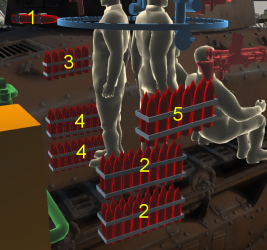
| Full ammo |
1st rack empty |
2nd rack empty |
3rd rack empty |
4th rack empty |
5th rack empty |
Visual discrepancy |
|---|---|---|---|---|---|---|
| 100 | 97 (+3) | 61 (+39) | 49 (+51) | 13 (+87) | 1 (+99) | No |
Notes:
- Racks disappear after you've fired all shells in the rack.
- To minimize rack detonation, it is recommended to empty all the way to the 3rd rack with 49 (+51) shells.
Machine guns
The Type 91 machine gun is mounted in the hull with limited traverse. With a limited magazine capacity, slow traverse speed, and small calibre, this machine gun usually doesn't serve much use in combat except as a tool against open-topped SPAA or tank destroyers, or to ping enemies on the map for teammates to see. As is common with many Japanese tanks, the turret is not fitted with a forward facing coaxial machine gun, so this machine gun is the I-Go Ko's only other weapon option if the main gun is incapacitated.
| 6.5 mm Type 91 | ||||
|---|---|---|---|---|
| Mount | Capacity (Belt) | Fire rate | Vertical | Horizontal |
| Hull | 3,000 (30) | 499 | ±22° | ±25° |
Usage in battles
The Type 89b I-Go Ko, despite its rather tractor-esque look, is a mobile tank that could use its speed to get to an enemy's flanks and cause some serious damage. The 57 mm cannon is unfortunately rather pitiful even in Rank I, with a penetration value of between 20 to 30 mm with APHE at standard combat ranges. Therefore, it is usually best to catch enemies unaware and go for flanking shots against their weaker side armour by driving around, instead of directly toward them. The 57 mm low-velocity shell does have an advantage of a rather prominent parabolic trajectory so it is possible to lob shells over hills to hit unsuspecting enemies behind it.
The gun's poor penetration will change when using the High Explosive Anti-Tank (HEAT) shell. This shell has 55 mm of penetration at any range but still has considerable drop-off due to the low velocity of the gun. It's a good enough anti-everything shell that can penetrate most targets you will meet, especially those pesky French tanks, which tend to be quite well armoured. The Type 3 HEAT shell, fortunately, has just enough penetration to get through them, although it is generally recommended to try to aim for weak spots and be prepared for the shell to not penetrate. This shell will also most likely destroy any truck or open-topped vehicle with a good hit.
Specific enemies worth noting:
Pretty much everything is a threat to this vehicle due to its mediocre mobility and poor armour. Fast vehicles like the M2A4, BT-5, A13 Mk I, and AMD.35 in particular are a difficult encounter; the I-Go Ko is reasonably fast at close quarters, but not that fast. The tank's sluggish turret traverse makes tracking a close target difficult and at long range the slow shells are difficult to aim precisely at a moving target. The 45 mm 20-K gun that the commonly encountered BT series have can easily destroy you at any range with a well-aimed shot.
Vehicles with autocanons and heavy machine guns like the M2A2, GAZ-AAA (DShK), Pz.II C, and T-60, are the I-Go Ko's worst nightmare. Their high volume of fire and good mobility coupled with the I-Go Ko's lack of a coaxial or pintle-mounted MG puts the I-Go Ko at a large disadvantage. SPAAs generally should be considered by the I-Go Ko to be just as deadly, if not more so, than conventional tanks.
One more vehicle type to worry about is aircraft. Due to the tank's roof being thin, aircraft with anything more than a heavy machine gun will be able to penetrate the I-Go Ko. Some examples of these include the 12.7 mm-armed P-26A-34 M2 and F3F-2, and the 20 mm-armed He 112 A-0 and D.500.
Pros and cons
Pros:
- Decent forward speed and good acceleration
- Parabolic trajectory lets you lob 57 mm rounds over hills
- APHE has a huge amount of explosive mass, especially for the calibre
- Type 3 HEAT shell has good damage output and can go through most tanks rather easily
- Great gun depression
- Shoulder-stabilized main gun which allows for stable shots at low speeds
Cons:
- Very poor armour layout
- APHE shell struggles to penetrate many of the tanks it will face, even from the sides
- Slow turret and hull traverse speed
- Tall for a Rank I tank
- No coaxial machine gun in the turret, the bow machine gun only fires forwards in a limited arc
- Tight crew spacing, which can result in the I-Go Ko being knocked out in one shot
History
Development
Japan's early pioneering into the concept of armoured warfare began as early as October 1918 during the first World War. They were able to acquire a few tank samples from the European governments, ranging from a British Mark IV tank, Medium A Whippet tanks, and Renault FT tanks. These tanks would make up Japan's first tank units in 1925. Their experiences with these tanks led to the eventual development of their own domestic tank design. The requirement for this new tank was given to the 4th Military Laboratory under the Imperial Japanese Army's jurisdiction and was mainly in charge of land vehicle development. In the summer of 1926, the first prototype was completed with the design of three turrets, one main in the middle and two smaller ones in the front and rear. The design was deemed too heavy at 18 tons and so development restarted, the initial design carrying on in the failed Type 91 and 95 tanks. During this time, a trial with a British Vickers Model C tank had the tank's gasoline engine catch fire. This prompted the Japanese to fit their tanks with a diesel engine instead. The development led to a new design in 1929, titled Type 89 I-Go. Though it is considered to be a light tank, the designation changed to a medium tank due to its weight of 10 tons.[1]
The Type 89's construction was assigned to Sagami Arsenal, but it was subcontracted to private firms due to Sagami's lack in industry. One of the firms was Mitsubishi Heavy Industries, which developed a tank plant specifically for the Type 89. The Type 89 production officially started in 1931, with mass-production in 1933 and continued until 1939 with 404 tanks built.[1]
Design
The Type 89 I-Go was Japan's first domestic tank design, yet it showed a lot of features that were revolutionary and would become a trademark of the Japanese tank designs. The Type 89 I-Go had a four-man crew in the tank with two in the turret. The turret held a 57 mm low-velocity gun meant for fighting fortifications due to the tank's role as infantry support. A peculiar feature on the Type 89 was the rear machine gun on the back of the turret. This machine gun was meant to enable the Type 89 to engage forward targets with a machine gun or its 57 mm gun and would be a design trend in future tank development.[1]
The Type 89 design changed gradually over time due to troop experience and advances in technology. For example, a small change that occurred for the Type 89 was the change of the commander's cupola from a "top hat" or "lid" design to a split hatch design. A noticeable change was in the engine when the first models produced off the lines were powered by a 118hp gasoline engine, these tanks were labelled as Type 89A I-Go Ko. It wasn't until 1934 when a change to 120hp Mitsubishi diesel engine was made that the Type 89 was redesignated the Type 89B I-Go Otsu. This diesel engine made the Type 89 the first mass-produced tank that uses diesel as its fuel.[1]
The Type 89 does carry its few flaws, however. The tank was quite slow at about 25 km/h (16 mph), a hindrance to mobile operations using motorized infantry that must wait for the tanks to reach the combat zone. The armour was quite thin at 17 mm and the 57 mm's anti-tank power was quite abyssal. However, against the Chinese troops from 1932 onwards, the armour and firepower flaws were small worries due to the lack of available tanks and anti-tank defences on the Chinese side.
Combat usage
The Type 89 was first used in 1932 in the 1st Special Tank Company after the Manchurian Incident. The company, armed with Type 89 along with Renault FT and NC tanks, took part in the conflict between China and Japan in the Shanghai Incident. The experience showed that the Type 89 performed well in comparison to the Renaults and soon the entire company was fitted with Type 89s, retiring the Renaults.[1]
The mass production of the Type 89 from 1933 onwards allowed the formation of large tank groups in Japan, leading to the 1st and 3rd Tank Regiment in Kurume, Fukuoka with the 2nd Tank Regiment at Chiba Tank School. The 1st Tank Regiment would be deployed with the Kwantung Army in China, where it would carry the Type 89 tank in the conflict against China from 1937 onwards.[1]
By 1939, the Type 89 was starting to be succeeded by newer Japanese tanks, but they still served on the frontlines such as the border conflicts between Japan and the Soviet Union. In the Battle of Khalkhin Gol, the IJA's 1st Tank Corps attacked the Soviet 11th Tank and 7th Armoured brigades in July with a mixture of Type 89s, Type 97 mediums, Type 95 lights, and tankettes in the 3rd and 4th Tank Regiments. Though the attack stirred up Soviet lines, there was no breakthrough in Soviet lines. The Soviets, armed with T-26 and BT light tanks, would soon push the Japanese back to Manchuria and have a cease-fire signed on 24 August.
Though the Type 89 was mostly withdrawn from service and replaced with the Ha-Go and Chi-Ha, the I-Go still served as far into the battles for the Philippines, Malaya and Burma. Some tanks saw further use as static pillboxes in the Japanese islands of the Pacific, but these tanks were vulnerable to newer anti-tank and tank technology of the Americans with their bazookas and M4 Shermans once they started their island-hopping strategy against Imperial Japan.
Even after World War II, some Type 89s were still seen in service of the French during the First Indochina War, using the captured Japanese armour in a unit known as 'Commando Blindé du Cambodge'.
Surviving Tanks
Many Type 89 relics still are visible in the wild usually reduced to a wreck with a handful of tanks still being in a good condition. These in good condition are located in:
- The Ordnance Training Support Facility, Ft. Lee, VA, USA.
- The Japanese Ground Self-Defense Force base at Tsuchiura, Ibaraki, Japan.
- Sinbudai Old Weapon Museum, Camp Asaka, Japan
- Villa Escudero, Tiaong, Quezon Province, Philippines
Only 1 I-Go Otsu remains in running condition, which was restored at the JGSDF base at Tsuchiura together with the last Type 3 Chi-Nu to still exist. Both are stored on military ground so aren't at all times in public display. The I-Go Otsu usually makes an appearance during the open day of the Tsuchiura base. The vehicle can be seen in media still running after being restored by the JGSDF.
Media
- Skins
- Images
- Videos
See also
- Equipment of the same adoption year
External links
- [Devblog] Type 89 I-Go Ko: First Series
- [Wikipedia] Type 89 I-Go medium tank
- [Tank Encyclopedia] Type 89 I-Go
- [Military Factory] Type 89 Chi-Ro
References
| Mitsubishi Heavy Industries (三菱重工業株式会社) | |
|---|---|
| Light Tanks | |
| Type 95 | Ha-Go · Ha-Go Commander |
| Medium Tanks | |
| Type 89 | I-Go Ko |
| Type 97 | Chi-Ha · Chi-Ha Kai |
| Type 1 | Chi-He · Chi-He (5th Regiment) |
| Type 3 | Chi-Nu · Chi-Nu II |
| Type 4 | Chi-To · Chi-To Late |
| Type 5 | Chi-Ri II |
| SPGs | |
| Chi-Ha Derived | Ho-Ro |
| Chi-He Derived | Ho-I |
| Chi-Ri Derived | Ho-Ri Prototype · Ho-Ri Production |
| Other | Na-To · Ro-Go Exp. |
| Captured | ␗Chi-Ha · ␗Chi-Ha Kai |
| Note | Most tank designs would be contracted by the Army Technical Bureau to Mitsubishi |
| See also | Mitsubishi Heavy Industries Ltd. (Post-War) |
| Japan light tanks | |
|---|---|
| Type 89 | I-Go Ko |
| Type 95 | Ha-Go · Ha-Go Commander |
| Type 98 | Ke-Ni |
| Other | Ka-Mi |
| IFV | Type 89 |
| Wheeled | Type 87 RCV (P) · Type 87 RCV · Type 16 (P) · Type 16 (FPS) · Type 16 |
| USA | ▅M24 · ▅M41A1 |


